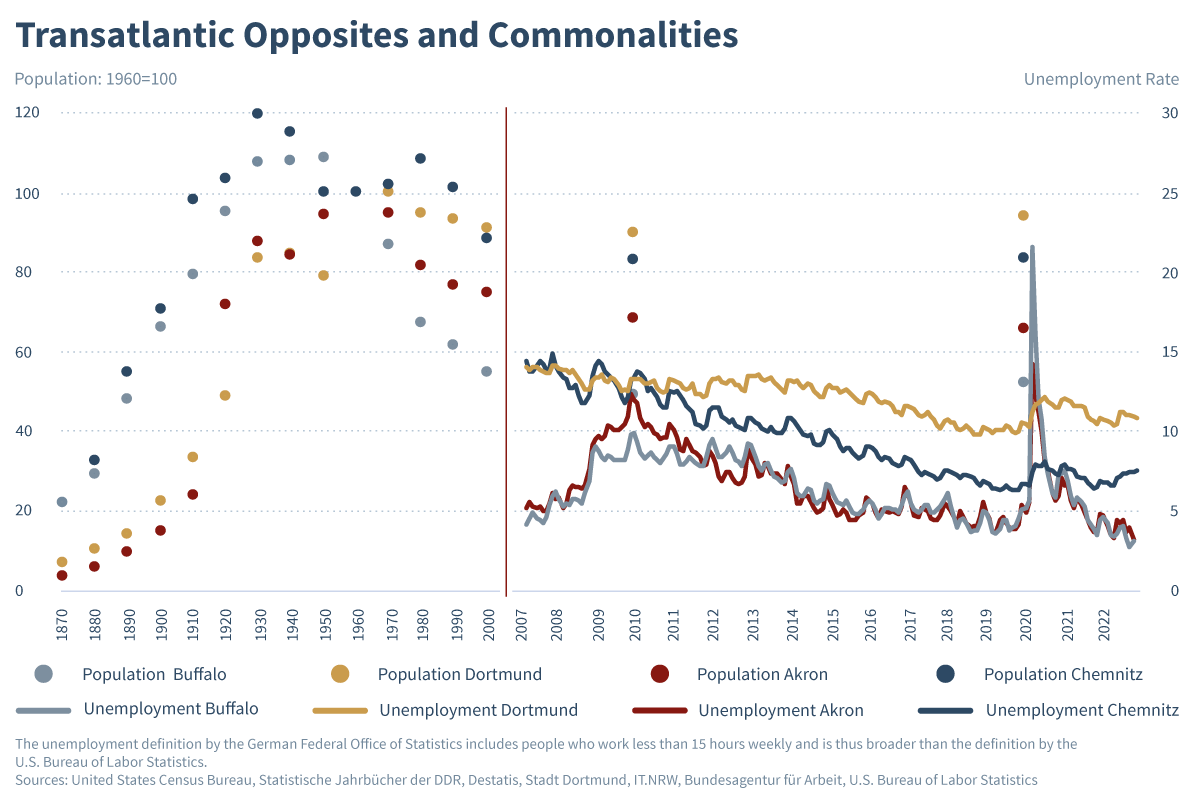Buffalo (New York) and Dortmund (North Rhine Westphalia) as well as Akron (Ohio) and Chemnitz (Saxony) are twin cities that share the history of deindustrialization. At the same time, they experienced rapid population growth and a globalization shock in the middle and end (East Germany) of the twentieth century. The structural change in the Rust Belt was accompanied by economic upheavals, which is still reflected in today’s reluctance for electoral participation. In this respect, social security and regional policy have had a stabilizing effect in Germany.

The Rise and Fall of Industrial Cities on Both Sides of the Atlantic

Buffalo (New York) and Dortmund (North Rhine Westphalia) as well as Akron (Ohio) and Chemnitz (Saxony) are twin cities that share the history of deindustrialization. At the same time, they experienced rapid population growth and a globalization shock in the middle and end (East Germany) of the twentieth century. The structural change in the Rust Belt was accompanied by economic upheavals, which is still reflected in today’s reluctance for electoral participation. In this respect, social security and regional policy have had a stabilizing effect in Germany.
The lively history of industrial cities is mirrored in their population growth. The economic rise of the Ruhr region led to a twelvefold increase in Dortmund’s population between 1870 and 1939. Over the same time, the center of German mechanical engineering was established in Chemnitz, where the population increased fivefold. In Buffalo, steel production and industrial grain processing developed. The population grew from just over 100,000 to almost 600,000. The Industrial Revolution most spectacularly hit Akron, a town of 10,000 in 1870, whose population multiplied to 250,000 by the 1940s, while bringing substantial wealth to the city as a global center of the rubber and tire industry.
However, Buffalo and Akron were unable to keep pace with international competitors in Europe and Japan after World War II. Symptomatic of many Rust Belt cities, they first lost competitiveness and then, in the mid-twentieth century, experienced a dramatic loss of population and economic strength.[1] By 2010, Buffalo’s population had more than halved. Nearly 30 percent of its residents turned their backs on Akron. Many highly educated white people moved to the more attractive coastal regions (“White Flight”).
The Karl Marx City of Chemnitz was incorporated into the postwar planned economy of the German Democratic Republic (GDR) as an industrial center and attracted a vivid influx until the fall of the Berlin Wall. However, the abrupt opening implied a late globalization shock. Not even the redirection of regional subsidies towards eastern Germany, which amounted to between four and five billion euros in the 1990s,[2] could avert emigration and deindustrialization. Compared to the depopulated neighborhoods of the Rust Belt agglomerations, the population decline in Chemnitz was smaller, but the loss of economic significance was experienced similarly.

The development of unemployment is a meaningful indicator of the importance of the different institutions. While the unemployment rate in Dortmund has approached the 10 percent mark from above and has gradually declined in Chemnitz in the last decade, the development in the United States has been much more erratic at a structurally lower level. After the 2008-09 financial crisis, Buffalo’s unemployment rate was close to 9 percent and temporarily dropped to below 4 percent by the pre-pandemic year of 2019. Akron experienced a similar trend at a slightly higher baseline level. Then, in the 2020 pandemic year, the unemployment rate jumped to 15 percent in Akron and to over 20 percent in Buffalo, only to recover immediately to pre-pandemic levels. In stark contrast to this “hire and fire” labor market, it was not least the short-time work benefit granted to German workers by the German government that stabilized employment in Germany.
The question of which system provides more stability in the long run cannot be answered conclusively. A comprehensive regional policy and a pronounced welfare state may promote the immobility of the population. On the other hand, an activating social and regional policy can raise the local employment potential and improve the competitiveness of a region by offering appropriate qualification programs. Offering prospects, but at the same time demanding a willingness to change, may serve as the gold standard for the German “coordinated market economy.” Conversely, the general conditions of a “liberal market economy” have the advantage of significantly lower costs for the state and taxpayers. Thus, the U.S. economy demands a greater tolerance for imposition in the working population. In return, the implicit U.S. social contract is based on a high degree of social mobility. Those who work hard enough, those who are flexible and mobile are given promising prospects for advancement. Nevertheless, the proportion of social climbers in the United States has declined significantly in recent decades and is now well below the German level.[5]
Particularly in the de-industrialized regions, disappointments about inequality of opportunity have been expressed at the ballot box. Beyond that, the regional differentiation of voter turnout is an interesting indicator as it often provides fertile ground for anti-establishment parties.[6] In Buffalo, turnout in the 2020 U.S. presidential election was just 53.6 percent—in Akron, 54 percent.[7] That is 10 or 13 percentage points lower than in New York State and Ohio respectively (United States as a whole: 67 percent). In Dortmund, on the other hand, voter turnout in the 2021 federal election was 74 percent and therefore only slightly below the NRW and national averages of 77 percent each. At 75 percent, almost as many people voted in Chemnitz as in overall Saxony.[8] While the Ruhr region is described by Diermeier and co-authors[9] as “conspicuously inconspicuous” with regard to the democratic system, this statement does not hold for Chemnitz. Instead, the Alternative für Deutschland (AfD) constitutes the second-strongest political force in Saxony where it is dominated by its far-right wing. Dissatisfaction with the democratic system is also particularly high in Saxony.
Thus, the analysis provides a mixed picture. In Germany, the welfare state’s guarantee of protection against existential risks and the active regional policy favor sociopolitical stabilization during structural change, even in deindustrialized regions. However, realizing that not even a lot of money can automatically buy consent for the democratic system is important for social peace, especially during imminent upheavals, like the current withdrawal from fossil fuels. This requires recognizing regionally different life achievements as well as conveying a perspective of a self-determined and successful future.

The Rise and Fall of Industrial Cities on Both Sides of the Atlantic

More on the topic

Pharmaceutical industry: Increasing pressure on the labor market
The shortage of skilled workers poses significant challenges for pharmaceutical companies in Germany and is expected to become increasingly problematic in the context of demographic changes. Concerning Germany's positioning in the international competition ...
IW
Industrial policy at the turn of the times
The current debate on industrial policy vacillates between the extreme positions of an orthodoxy of rejecting state action and a naive belief in the state's ability to control structural change.
IW